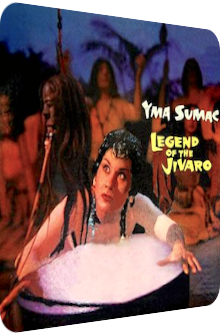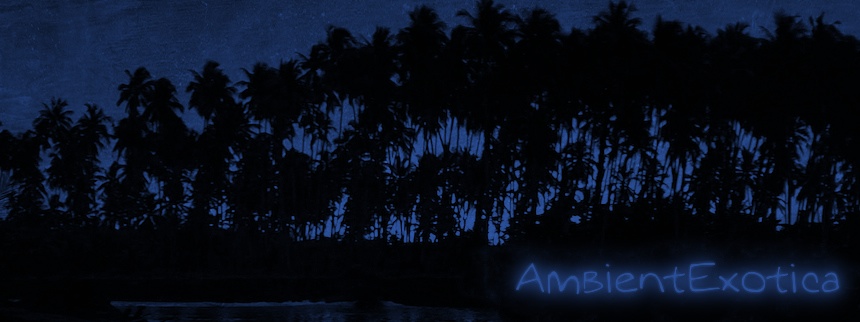
Yma Sumac
Legend Of The Jivaro
1957
The premise of the octave-traveling enchantress Yma Sumac’s (1922–2008) Legend Of The Jivaro starts with a lie. It is a lie often heard and easily accomplished in the 50’s: tell a vivid story, take a stage persona that breathes and lives this cock-and-bull story, and as a marketing buff, your work flourishes. This is not to say that Yma Sumac herself has suddenly succumbed to such tomfoolery, but the circumstances of this album are shrouded in mystery, and this is accomplished by the liner notes.
Released in 1957 on Capitol Records and written by Sumac’s then-husband Moises Vivanco, the 12 original compositions on her first 12" LP have been inspired by the Peruvian Jivaro tribe which is said to provide the backing vocals on this album. Hmmm. This would be fair game, were it not for the ornamental language that fakes months of contiguous research on this subject. I’m by no means a cynic, but this is hard to believe at this stage in Yma Sumac’s career. The talented singer has a more than successful career throughout the 50's and is firmly established, so why bother trying to absorb the realness of the Jivaro tribe? I believe that said tribe really gave the primary inspiration, but that everything else was then envisioned by Vivanco and Sumac as it has happened previously time and again. But the album is noteworthy for something else: after the gleeful fan favorite Mambo! (1954) which decreased the mountainous mysticism in favor of Latinized valleys and scything brass bubbles, Legend Of The Jivaro is a return to form.
This does not necessarily imply that Mambo! is a black sheep – it’s considered Sumac’s best album after all – but rather that remoteness and arcane traditions have returned full force. It is a work full of rituals, secrets, foreign celebrations. What it lacks is also of note: Sumac appears fully embedded in the arrangements, has become one with the surroundings. Her vocal range is much narrower. This is purposefully done in order to let the overall harmonies reign. A closer look is given below.
Jivaro opens side A with a bellicose portent, a faux-ritualistic dance that bewails the vicissitudes and scars of anger and war. The muffled drums are spooky, Sumac’s vocal performance aggressively lamenting. The sorceress keeps a lower spirit than usual while still residing in the epicenter, focusing more on the mephitic mood than a presentation of histrionic outbursts. The lamento of the male choir rounds off a soul-crushing prelude. Sejollo (Whip Dance) then is a beautifully pentatonic sparkler of 100 seconds, unexpectedly Japanoid due to its silky syrinxes, the wooden claves and shell percussion. The mixed choir further lifts up the good mood, its cheers of encouragement being reminiscent to Martin Denny’s Afro-Desia (1958). This is Exotica indeed, a blending of different flavors and styles.
Yawar (Blood Festival) is yet again much more benign and genteel than its title suggests. Loaded with wind chimes and plinking percussion, it is the warbled mountain fife and sunset-colored acoustic guitar which amend to Yma Sumac’s agglutinating verve. The intrinsic loftiness continues with Shou Condor (Giant Condor), a drum-underlined ballad about the freedom this majestic creature enjoys. The vocals are hence fittingly placed amid the ether and are at the same time down to earth in order to showcase man’s inaptitude to fly. The soothing flutes round off a beautifully reduced gem. While Sauma (Magic) presents an uncannily sinister marimba-backed procession of droning choirs and an unbelievably oneiric atmosphere which also shows the rise of the temptress’ voice, Nina (Fire Arrow Dance) closes side A with a bucolically bubbling midtempo diorama that is less belligerent than the liner notes delineate; the Jivaro may have killed quite a few Spaniards with their fire arrows, but this depiction is not reflected in the flute-filled soundscape itself.
Sansa (Victory Song) launches side B with the first appearance of soft mountainous horns, however, this composition is much more fond of the cross-linkage between sound, sustain and silence, with the afterglow of the drums and vocals echoing through the diaphanous air. The following Hampi (Medicine) is the only instance of a composition written by composer Bill Hitchcock. It is the utmost minimal arrangement in terms of Exotica: enigmatic drums and vocals that are no less shrouded in mystery. There is a flute on board alright, but the mellow monotony of the drums is in the spotlight. Soothing yet alienating, this piece fittingly enshrines Yma Sumac’s trademark sound… with the barest of layers.
Sumac Sorateña (Beautiful Jungle Girl) is another vignette of 100 seconds and the most uplifting one it is too. Various hey! chants, vitreous Peruvian cowbells and the feeling of companionship make this the bonfire ditty of the album, with Aullay (Lullaby) presenting a different kind of choral polyphony as a dusky glow encapsulates the flutes, woodwinds and zithers. The evening atmosphere is downright magnificent, a sense of real tribalism shimmers through every note. Batanga-Hailli (Festival) is the counterpoint, as it is another handclap-accompanied Peruvian Folk dance in the upper tempo regions – intrinsically speaking – with a focus on the choir and the flutes. Wanka (The Seven Winds) finishes the album with a ballad full of tubular instruments whose raspy wind gusts work well with a Sicilian guitar and Yma Sumac’s wordless mumblings. Euphonious flute washes round off the apotheosis to a serious album.
Legend Of The Jivaro is as much of a reaction to the dance-driven togetherness of Mambo! as it is a continuation of the formula Moises Vivanco and Capitol Records tailored to the talented singer. It becomes apparent, however, that the contemplation and remoteness of the faraway mountains as depicted on this album are equally keen on spreading out a different kind of bond, one that is much more deep and meaningful than all the Sambas, Mambos and Merengues of the world. The choir is always fond of echoing Sumac's sentiments, but here it seems to have gotten an even bigger role, one which makes it function above the conception of a human instrument.
The topics of war, bravery and pride are poured well into the mould. Sometimes the illusion of real traditions is so immersive and contingent that the thought of Legend Of The Jivaro being a mere Exotica album is put to the test. This very test brings with it a patient listener, a curious remark considering the average length of the compositions being two minutes and thirty seconds. But the material seems to be much longer, the scope larger and the scenery more distant, with all of these feelings and sentiments usually occurring when a work crosses the boundaries to fantasies. In the end, Legend Of The Jivaro is a clear genre artifact, paving the way to real dedicated studies such as Elisabeth Waldo’s Rites Of The Pagan (1960) and Realm Of The Incas (1961). It is available on vinyl and remastered digital incarnations.
Exotica Review 373: Yma Sumac – Legend Of The Jivaro (1957). Originally published on Sep. 13, 2014 at AmbientExotica.com.
